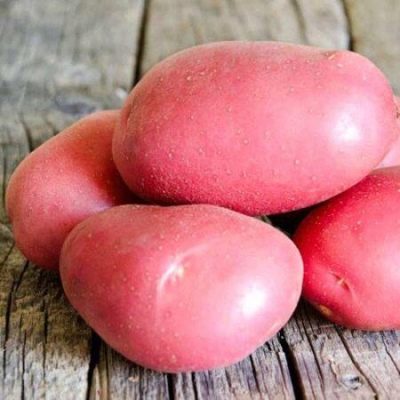
- Authors: Koksharov V.P., Klyukina E.M., Shanina E.P. (FGBNU "Ural Research Institute of Agriculture")
- Year of approval: 2009
- Appointment: dining room
- Tuber size: large
- Tuber weight, g: 96-108
- Peel color: red
- Color of the pulp: light yellow
- Starch content,%: 12,2-16,8%
- Tuber shape: elongated oval
- Peel structure: smooth
Potatoes are one of the most popular and demanded vegetables, so every year they create more and more new varieties that quickly adapt to the climatic conditions of the growing region. These include the early maturing variety Kamensky of domestic selection.
Breeding history
Table potatoes Kamensky is the result of the successful work of Russian breeders of the Ural Research Institute of Agriculture. The nightshade culture joined the ranks of the State Register of Breeding Achievements in 2009. It is recommended to grow the variety in three regions - Volgo-Vyatka, West Siberian and Ural.
Description of the variety
Kamenskiy is a tall, erect or semi-erect shrub of an intermediate type, which has strong pigmented stems, moderate foliage with tough dark green leaves and a developed root system. The bushes bloom in the second half of June. During the flowering period, large red-violet flowers are formed on the potato bush, collected in inflorescences.
Characteristics of the appearance of the bush and root crops
14-25 tubers are formed in one bush. Root crops are characterized by an elongated oval shape and a smooth surface with a pronounced gloss. The variety is large-fruited, so the tubers ripen large - on average 96-108, and sometimes up to 130-150 grams. The peel of the potato is quite dense, with a mesh cover and many small eyes, set shallowly. The color of the peel is beautiful - red or deep pink.
The harvested crop can be transported over long distances without losing the commercial qualities of the tubers. In addition, dug potatoes can be stored for a long time, the main thing is that the cellar is cool (no higher than 3-4 degrees Celsius), and there is no high humidity.
Purpose and taste of tubers
Kamensky is famous for its excellent taste. The taste of the vegetable is pleasant. The pale yellow flesh has a dense, oily and delicate texture without wateriness. When cleaning and heat treatment, the pulp of vegetables does not change color, remaining yellowish-creamy. The pulp contains less than 17% starch and a large amount of potassium and magnesium. The variety is moderately varied.
The advantage of the variety is its universal purpose - potatoes are added to first courses, boiled, stewed, fried and baked. In addition, tubers are good for making salads, boiling in a peel, freezing as blanks.
Maturation
The variety is early maturing. From the moment of mass germination to harvest, only 60 days pass. The first digging can be done after 45 days. The period of full digging of potatoes falls on the first half of July. Sometimes the ripening dates can be shifted against the background of unfavorable weather conditions.
Yield
The variety is high-yielding. By providing the crop with standard agricultural techniques, you can get an excellent harvest. On average, 185 centners of tubers are dug per hectare of plantings. Under favorable conditions, the indicators can grow up to 252 centners per hectare. With early digging (after 45 days), you can count on 90-95 centners per hectare.
Growing and care
It is recommended to plant potatoes in the first half of May, while the soil should warm up and the temperature regime should stabilize (+12 degrees). For planting, medium-sized potatoes are selected without damage, weighing 50-80 grams, with clear shoots 1.5-2 cm long. Optimal for planting is a scheme of 30 by 60-70 cm. Potatoes should not be planted in place of tomatoes, eggplants and sweet peppers, otherwise, it may be exposed to fungi that affect the above cultures.
Care for the nightshade crop is standard - infrequent watering (after mass shoots, when buds appear and at the end of flowering), top dressing (three times per season), hilling (twice during the growth period), loosening and weeding of row spacings, prevention of diseases and viruses.

Planting potatoes is one of the main spring activities traditional for Russian gardeners. There are many ways to plant this vegetable, allowing you to get a good harvest in different conditions and climates. Before planting, you need to carefully prepare the planting material, correctly determine the timing, competently prepare the soil.


Soil requirements
The variety is not very picky about the soil, but the soil should not be acidic and waterlogged, excessively wet. Potatoes are most comfortable to grow in nutritious sandy loam soils, which are breathable and well fluffed.

Required climatic conditions
Kamensky is a culture that loves warmth, light, moderate moisture, and is also resistant to prolonged drought. Drafts, sharp temperature fluctuations, stagnant moisture, cold wind negatively affect the development of the plant. The best place to grow will be a site cleared of weeds, which is abundantly illuminated by the sun.
Disease and pest resistance
Thanks to a strong immune system, potato bushes are resistant to a number of diseases - leaf curling, cancer, wrinkled and banded mosaics, common scab and rhizoctonia. Potatoes are less resistant to late blight of tubers and leaves. The most dangerous disease for this variety is the golden nematode. To protect against diseases, it is worth observing the crop rotation.

Potatoes are a popular vegetable crop that many gardeners planted on their site. But growing a bountiful harvest of tasty and large tubers is unlikely to succeed if the beds are not properly protected from the most common diseases and pests. Often, the development of diseases of various etiologies of potatoes goes unnoticed, so it is important to identify the problem in time and eliminate it.
















































































